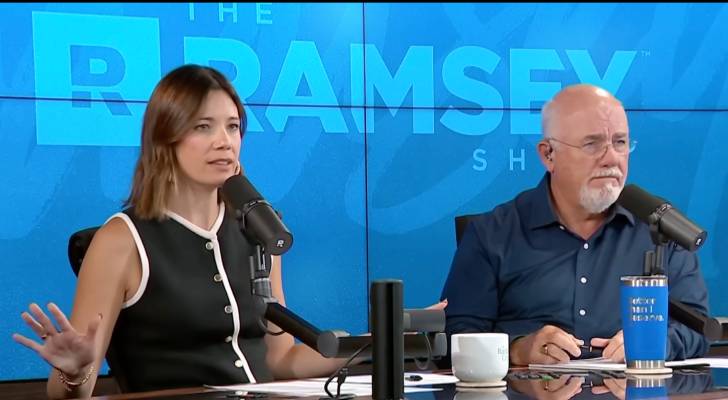Jim, a 26-year-old from Texas, recently called into The Ramsey Show (1) with a financial crisis that defies logic: despite skyrocketing his income from $25,000 in 2022 to $195,000 this year, he and his 25-year-old wife are drowning in $500,000 of debt, and she doesn’t know the full extent of it.
The couple’s debt breakdown includes a $330,000 mortgage, $50,000 and $35,000 in vehicle loans and roughly $80,000 in credit card debt that Jim’s wife may think is only $15,000 to $20,000.
Combined with Jim’s wife’s $55,000 salary, they’re pulling in a quarter-million dollars annually — yet they’re broke.
“What you’re really asking,” Dave Ramsey said, “Is ‘how do I get my wife to get on a plan because our current plan sucks.'”
The most glaring issue? Jim works as an independent contractor (1099), meaning no taxes are automatically withheld from his paychecks. He admitted he hasn’t filed his 2024 taxes yet and already owes an estimated $25,000 from 2023, with thousands more due this year.
“Your tax lady sucks,” Ramsey said. “How in the world are you making that kind of money and not doing quarterly estimates?”
According to the Internal Revenue Service (IRS), self-employed people must typically make estimated tax payments if they expect to owe $1,000 or more when their return is later filed. Each year is divided into four periods with a tax payment deadline. (2)
And the penalty for ignoring this requirement can be steep. Those who don’t pay enough tax throughout the year may face a fine for underpaying.
If you’re an independent contractor, like Jim, financial advisors recommend several beginner-friendly strategies for managing taxes.
For example, to figure out your quarterly payment estimate, use IRS worksheets to calculate it, or divide last year’s taxes by four as a starting point. This can even potentially be automated to save yourself some time — just set it and forget it.
Another good practice is to create a solid record-keeping process from the get-go of both your annual income and expenses. An expense app to track receipts and other deductible expenses can help to streamline this.
Story Continues
And if you’re earning six figures, like Jim, setting aside 25 to 30% of each payment for taxes (both income and self-employment) is common. This means Jim should have been banking roughly $50,000 annually just for the IRS. Instead, that money likely disappeared into spending.
Read more: Robert Kiyosaki warns of a ‘Greater Depression’ coming to the US — with millions of Americans going poor. But he says these 2 ‘easy-money’ assets will bring in ‘great wealth’. How to get in now
Ramsey and cohost Rachel Cruze advised Jim to tackle the IRS bill first, then the rest, using the debt snowball method.
This approach involves paying off the smallest of all your loans as fast as possible. Once that’s completely paid, the money you used to do so rolls onto the next-smallest debt owed, and so forth, as you go down the list to the largest debt.
As this happens, the amounts being paid off increase, and the rate at which you’re reducing the debt “snowballs” or grows.
So, for Jim and his wife, the priority order should be:
IRS debt ($25,000+): Must be paid to avoid penalties and liens
Credit cards (about $80,000): Likely carrying the highest interest rates
Vehicle loans ($85,000 combined)
Mortgage ($330,000): Typically the lowest interest rate
With their combined $250,000 income, if they lived on $90,000 and put the remaining $110,000 toward debt, the cohosts pointed out, they could potentially be debt-free (excluding the mortgage) within two years.
The bigger question is: where did all the money go? With $250,000 and only three years to accumulate this debt, the answer is likely lifestyle creep. This is what happens when you spend more as your income increases, sometimes to the point that you can’t pay off debt or save.
As Jim’s income jumped from $25,000 to nearly $200,000, the pair financed vehicles totaling $85,000 and racked up $80,000 in credit card debt — all while failing to set aside money for taxes or build savings.
It’s wise to understand what lifestyle creep looks like and check in on yourself. Two telltale signs: when you feel more comfortable with higher regular expenses, or when there’s less than you expected in your bank account and you aren’t quite sure why.
Ramsey’s final advice cut to the heart of the issue: “This is not you telling your wife what to do. This is you saying, ‘Honey, join me in being a grown-up and living on less than we make.'”
The couple needs to sit down together, list every debt, cut up their credit cards and create a monthly budget where every dollar has a name.
It’s not about blame, but about building a system that works with discipline, transparency and a solid repayment plan, to transform their financial future.
Join 200,000+ readers and get Moneywise’s best stories and exclusive interviews first — clear insights curated and delivered weekly. Subscribe now.
We rely only on vetted sources and credible third-party reporting. For details, see our editorial ethics and guidelines.
The Ramsey Show Highlights (1); Internal Revenue Service (2)
This article provides information only and should not be construed as advice. It is provided without warranty of any kind.

